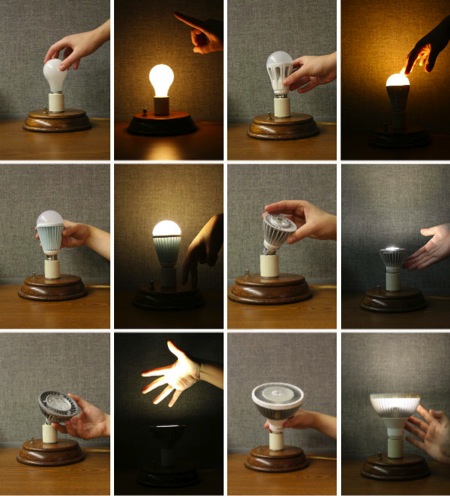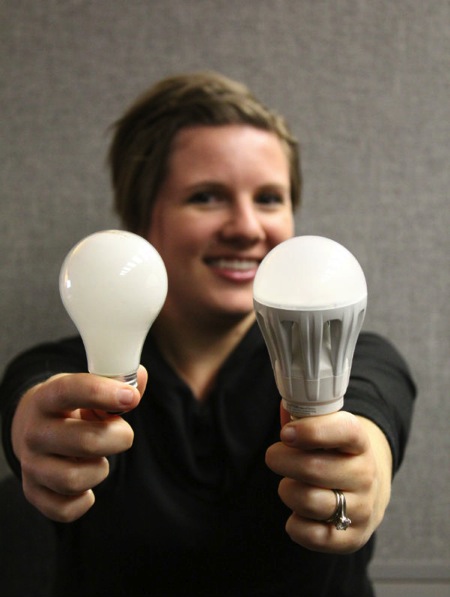
Image: Marcia Prentice
Moving to LEDs is the latest trend in lighting! The Louvre Museum in Paris is gaining national recognition for their commitment to replacing its exterior lighting with LED lighting. In the beginning of 2012, the U.S. National Mall in Washington D.C. switched out their mix of HID and CFL light bulbs for LED light bulbs. Changing out the bulbs to LED will result in an approximate 65 percent energy saving. Are you ready to switch out your incandescent or CFL bulbs for LEDs? You will be surprised by how far LED light bulbs have become more commonplace in the last few years. So what is an LED?
To find out what all the LED hype was about, I headed down the hall to our light bulb buyer's office to round up a handful of LED bulbs and get a quick LED light bulb lesson. I then surprised my co-worker and Style Illuminated blogger, Lesley, by asking her to be a model in my photos, which afterward she confessed was quite fun.

Incandescent Light Bulb (left) and LED Light Bulb (right); Image: Marcia Prentice
After testing all the different types of LED light bulbs, you can see the different types of light emitted from each bulb. LEDs are made to emit directional light, but the standard indoor-outdoor light bulbs are made to look like a classic incandescent bulb and have a similar glow. One of the big concerns when switching from incandescents to compact fluorescents was the quality of light wasn't preferred. With LED light bulbs, the quality of light is similar to that of an incandescent. The LED light bulbs are significantly more efficient and the quality of light is similar; have I convinced you to make the switch yet? Keep reading for the benefits of LED.
What is LED?
I am sure you heard the term "LED" thrown around, but may not be very familiar with how LED lights work or how to incorporate them into your own home. LED stands for light emitting diode: a semiconductor light source. When I think of LEDs, the first thought that comes to my mind is an LED light show at a party that we all want to attend. Did you know that they also have many practical uses in the home? LEDs have come a long way in the last few years. One of the most significant ways to incorporate LED lights in your home is by installing LED recessed downlights. Imagine not having to replace recessed light bulbs for many many years. Talk about saving a lot of money and hassle of climbing up on a ladder to try to switch out the light bulb.

Image: Marcia Prentice
Benefits of LED?
•Long lasting: You will probably be ready for a new style of lamp before the LED light bulb needs to be replaced. No more worrying about having spare light bulbs around the house.
•No Mercury: Concerned about the environment and disposing of compact fluorescent light bulbs, which contain Mercury? LED light bulbs don't contain mercury so they are better for the environment, better for everyone.
•More Efficient: LED lights are more efficient (when comparing light per watt) than incandescent and CFL light bulbs.
•Dimmable: Just like an incandescent bulb, LEDs are able to be dimmed for any type of lighting situation. Make sure your LED is dimmable if this is a need.
•Not Hot: Have you ever accidently touched a hot incandescent light bulb? It hurts! Well... you don't have to worry about LED light bulbs getting too hot to touch. LEDs radiate very little heat. The flanges on the base of the bulb help wick away heat.
•Don't Attract Bugs: LED light bulbs are ideal for outdoor lighting because the spectrum of light they put out does not attract bugs
LED Considerations:
•LED Dimmers: When purchasing a dimmer with your LED light bulb, make sure the dimmer works with that particular type of bulb.
•Finding an Incandescent Comparable: LED light bulbs are differentiated by their lumens, not wattage. Compare the lumens of an incandescent bulb to the lumens of a LED bulb to find its equivalent.
LED Light Bulbs Can be Used in Many Different Types of Fixtures:
•Recessed downlights
•Table lamps
•Wall Lights
•Track Lights
•Hanging Pendant Lights
•Outdoor Lights
•and more...